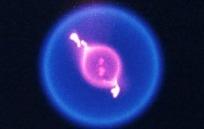Great Balls of Floating Fire
Astronauts burn droplets of fuel in space to study combustion.
In space, a drop of fuel burns in a sphere, symmetrically sucking in oxygen and producing heat and gas equally on all sides. With no gravity to make hot gas rise, flames lack the teardrop shape they assume on Earth. “It’s a ball of fire, more or less,” explains Forman Williams, a combustion researcher at the University of California, San Diego.
Williams is the principal investigator for Flame Extinguishment Experiment 2, or FLEX-2, which studies these fireballs on board the International Space Station. Williams hopes his experiment will provide insight into the basic physics and chemistry of combustion, and lead to improved fire safety in space.
FLEX-2 takes place in the 560-pound Combustion Integrated Rack, which is located in the station’s Destiny lab module. Inside the rack, an apparatus about the size of a bread box can be filled with different mixtures of oxygen, nitrogen and helium gas. Tiny droplets of fuel, like methanol or heptane, are dispensed into the combustion zone through a syringe. “Since there is no gravity, the droplet just sits there,” Williams says. The droplets are ignited and can burn for up to 20 seconds or so (the exact time depends on the gas and fuel), shrinking as the fuel is consumed. While one camera records the droplet size, radiometers and an ultraviolet camera record the flame radiation, and another visible-light camera records the droplet and the flame.
Last summer, astronauts completed multiple rounds of experiments, typically doing four to 10 droplet burns in a session, twice a week. The first FLEX experiment studied the physics of flame extinction — how flames die out when there’s not enough fuel or oxygen — and was geared toward spacecraft safety. FLEX-2 is “more science-oriented,” says Williams, and is investigating fuel mixtures that might be used in high-efficiency automobile engines.
In the video above, a suspended droplet of heptane burns for a couple of seconds in a “hot flame,” then — when the scene appears mostly dark — burns in a “cool flame,” a steady, lower-temperature combustion. Finally, the droplet extinguishes in a bright orange vapor cloud.
The team has already made one interesting observation. “We were burning these heptane droplets out there on station, and we saw the hot flame extinguish, but the droplet kept decreasing in size. It was just like if it was burning, but we could not see any flame — it was almost like an invisible flame was causing these heptane droplets to burn steadily,” Williams says. “We didn’t even believe it for a year.” The team’s research was published in the December 2012 issue of the journal Combustion and Flame.
“Cool flames” have long been known to exist, but understanding more about how they work could help in the development of efficient, low-emission engines. Alternative fuels used by these types of engines often produce cool flames during combustion.
“If we hadn’t done these experiments in station, this phenomenon would not be known today, so we were really excited about that,” Williams says.
Rebecca Boyle is an Air & Space contributor based in St. Louis.
